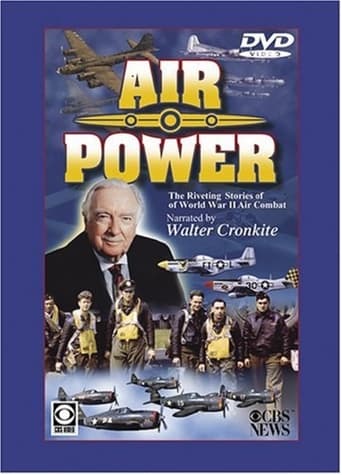Air Power (1956)
Air Power
1956
Air Power is a historical educational television series broadcast during the 1956-1957 television season over the CBS television network dealing with the rise of aviation as a military weapon. It starred Walter Cronkite as the narrator and featured a musical score by Norman Dello Joio.
Seasons & Episode

The rise of the German Luftwaffe, told with the use of German film captured during World War II.

The story of the Japanese attack on Pearl Harbor, Hawaii, on December 7, 1941, which brought the United States into World War II. The episode uses Japanese film captured during the war to depict Japanese preparations for the attack and the attack itself.

Co-narrated by Michael Redgrave. The story of the World War II Battle of Britain in the summer of 1940, in which the British Royal Air Force defeated the German Luftwaffe′s campaign to gain air superiority over the United Kingdom and prevented Operation Sea Lion, Nazi Germany′s planned invasion of the United Kingdom, from taking place.

How the British Royal Air Force mounted a counterattack against Nazi Germany during World War II even while the United Kingdom was under attack by German bombers. The episode includes depictions of British air raids on Hamburg.

Co-narrated by Art Carney. A look at aviation during the 1920s, including stunt flying, wing walking, and barnstorming.

The United States Army Air Forces bomb oil refineries around Ploești, Romania, as part of the oil campaign of World War II.

U.S. Army Air Forces bombers attack Schweinfurt, Germany, in an attempt to cripple the German ball bearing industry during World War II.

The story of the U.S. Army Air Forces North American P-51 Mustang, the high-performance long-range fighter that played the major role in giving the Allies air superiority over Germany during World War II.

At the outset of the Pacific campaign of World War II, Japanese forces sweep through the Philippines, British Malaya, Singapore, and the Netherlands East Indies between December 1941 and May 1942, but their offensive finally ends in defeat at the hands of United States Navy aircraft carrier forces in the Battle of Midway in June 1942.

Allied and Japanese forces fight in the New Guinea campaign and the Battle of the Bismarck Sea during World War II.

In the spring of 1944 during the Italian campaign of World War II, Allied air forces interdict German supply lines in Italy in Operation Strangle as Allied ground forces attack the German Gustav Line, fight the Battle of Monte Cassino, and liberate Rome.

In late 1943 and early 1944, United States Navy aircraft carriers go on the offensive against the Japanese during the Pacific campaign of World War II, operating in support of U.S. forces during the Gilbert and Marshall Islands campaign — the seizure of Tarawa and other atolls in the Gilbert and Marshall Islands — and launching a major air attack against the Japanese base at Truk.

To secure bases for U.S. Army Air Forces Boeing B-29 Superfortress strategic bombers within range of the Japanese Home Islands, U.S. forces invade the Mariana Islands in the summer of 1944.

The story of air power's role in the destruction of the German 7th Army in France in the summer of 1944 in World War II′s Operation Cobra and Battle of the Falaise Pocket.

The last stages of World War II in Europe in the winter and spring of 1945, as Soviet forces capture Berlin, Soviet and Western Allied forces meet at the Elbe, and Germany is left in ruins.

Between October 1944 and August 1945, Japanese aircraft make kamikaze suicide attacks against Allied ships.

The story of the top-secret production of the U.S. atomic bomb and its use against the Japanese cities of Hiroshima and Nagasaki, leading to the surrender of Japan that ended World War II.

As the Cold War begins after the end of World War II, the Soviet Union institutes the Berlin Blockade of West Berlin, prompting the Western Allies to conduct the Berlin Airlift of 1948–1949.

After the Korean War breaks out in June 1950, United Nations and South Korean forces are pushed back, then regain the initiative and drive North Korean forces all the way back to the Yalu River along the border with the People's Republic of China.

The People's Republic of China intervenes in the Korean War in November 1950 and pushes United Nations forces back, resulting a lengthy stalemate along the border between North Korea and South Korea. Meanwhile air battles between American and Soviet jets begin over the Korean Peninsula. Ultimately, the opposing sides agree to a ceasefire in July 1953.

The story of the design and testing of the Lockheed F-104 Starfighter supersonic interceptor.
Air Power is a historical educational television series broadcast during the 1956-1957 television season over the CBS television network dealing with the rise of aviation as a military weapon. It starred Walter Cronkite as the narrator and featured a musical score by Norman Dello Joio.
Watch Trailer
Free Trial Channels























